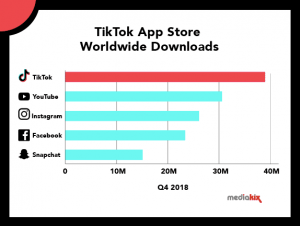What brands are doing on TikTok, and how to know if you should join in

Image credit: CannesLions.com
TikTok is just a place for kids to share silly videos with each other, right?
The Internet, it seems, is not without a sense of irony. The very places where we’re seeing people writing off the latest super-platform are the same places that those same people wrote off 5-10 years ago: Twitter, Linkedin, Facebook, even blogs.
That’s how trends go – High School and University kids are quick to adapt, they’re creative and they have strong social networks, so it just makes sense that they would be the first to jump on board. It doesn’t hurt that TikTok has spent a reported $1 billion on advertising to get at the coveted “young people” demographic.
The reality is that over 500 million people are now TikTok-ing. That’s roughly equivalent to Twitter and LinkedIn combined. Not to mention the fact that a story about High Schoolers using TikTok at school just hit the front cover of the New York Times.
Even more impressive than the total number of users is its continued growth. In Q4 of 2018 it surged past the big four apps to become the most downloaded social media platform in the world.

Despite the staggering number of people using TikTok, very few brands have jumped in, but that’s probably a good thing. Rather than fly at every shiny new thing, smart marketers educate themselves on every opportunity a new platform has to offer, then decide if it matches their audiences and objectives.
That’s why we’re here: To give you the inside look, to dig into what’s going on, what the brands that are already there are doing, and how it may apply to you. But first, let’s start with the most important question: What is TikTok?
I’ll borrow a definition from New York Times Style writer, John Hermann:
TikTok is an app for making and sharing short videos. The videos are tall, not square, like on Snapchat or Instagram’s stories, but you navigate through videos by scrolling up and down, like a feed, not by tapping or swiping side to side.
Video creators have all sorts of tools at their disposal: filters as on Snapchat (and later, everyone else); the ability to search for sounds to score your video. Users are also strongly encouraged to engage with other users, through “response” videos or by means of “duets” — users can duplicate videos and add themselves alongside.
Here’s a personal favourite from the Carolina Panthers, just to illustrate John’s point:
A lot of the content that you’ll find on TikTok is a riff on an existing meme – creators will take one audio loop (called “Sounds”) and add their own take on it. Here’s how one creator used the same TikTok sound:
What’s unique about TikTok, aside from the way that content is set to music, is the way that you discover new content. Unlike every other social media network where your friend network is the most important part of your experience, TikTok opens directly to the For You page, which is a feed of trending content that TikTok has identified you are most likely to engage with.
Because it’s primarily content-based and not network-based, users are much less concerned with who published the piece than they are with how entertaining it is. In that way, it’s much more democratic than any network that’s come before it, where anyone’s content can get in front of millions of viewers at any time.
The way that content spreads is largely through hashtags. Given that discovery is key, and memes are a cornerstone of TikTok content, hashtags are the glue that binds them all together.
Sometimes they curate a trend, as in #GetSpooky.
Other times hashtags are used to call out the content type, like #GymWarriors.
And, because it’s the Internet, sometimes people take the intended use of an app and flip it completely on its head. Right now there are over 46 billion views of the hashtag #EduTok where people are creating short clips to educate each other. The trend has caught on particularly well in India:
The challenge for brands is that we want to see direct results. Brands like proven marketing channels with case studies and best practices. At the same time we look at the success that brands like Red Bull and NatGeo earned when they were first to jump on new platforms and wonder why we didn’t do the same. Every new platform comes with challenges, but it’s in the early days before there are established methods that the real opportunities to build an audience and connect with a new group of people exist.
What we know to be true is that right now there is a massive, engaged audience on TikTok that is no longer paying attention to the channels that we’ve all been investing in for the past decade.
Fortunately, there are a few brands who have made the leap that we can all look to learn from:
Chipotle
The San Diego Zoo
The Canadian NDP Party Leader Jagmeet Singh
The NFL
The Washington Post
I can’t help but respect the people at these brands taking a shot at something new, knowing that they’ll almost definitely stumble along the way, and having the courage to justify their time investment to the people who write their cheques.
Here’s what I suggest to those of you who have that same level of respect, and may be considering dabbling in TikTok for your own brand:
Start with your audience – are they there? You don’t need to be exclusively marketing to teens for it to make sense, but you’re likely not selling timeshares in a retirement community.
Have some real talk with yourself about objectives – is brand exposure and sentiment important to you? Is it really important? If not, then you’re never going to be happy making silly Internet videos just to get some love and appreciation. If you are a traffic and revenue-focused brand, then buy Facebook ads, but if you’re thinking more longterm about developing a brand and an audience, then you may just be right for TikTok.
Then, the content – can you, and are you willing to, create content that is 100% built for entertainment purposes? Fresh new spaces like this are especially allergic to obviously branded content.
Finally, the relationships – by far the best way to break into a new space like this is to find people who have already figured it out, and who love your brand, then support them in doing more of what they do. You may call it influencer marketing, or branded integrations, or sponsorship, but I think that it just makes sense.
Want to go even deeper into the weeds of TikTok? The crew over at Hootsuite put together a pretty comprehensive post called What is TikTok, Who Uses It, and Should Brands Care About It?


